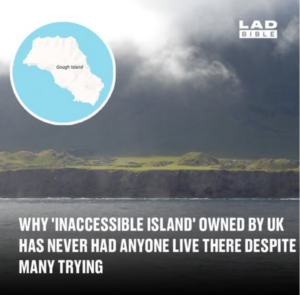Why ‘Inaccessible Island’ Has Never Had Permanent Residents Despite Many Attempts
Deep in the South Atlantic Ocean lies Inaccessible Island, a remote and mysterious landmass that, despite its name, has drawn explorers and settlers for centuries. Owned by the United Kingdom as part of the Tristan da Cunha territory, this rugged volcanic island has resisted human habitation time and time again.
While many have attempted to settle there, nature has always won. From harsh weather to dangerous terrain and a complete lack of resources, Inaccessible Island remains one of the last truly untouched places on Earth.
A Land Lost in Time
Inaccessible Island is a 14-square-kilometer volcanic island, located about 2,300 kilometers from South America and 1,750 kilometers from Africa. The nearest inhabited land is Tristan da Cunha, which itself is considered the most remote inhabited island in the world.
It was first discovered in 1656 by Dutch sailors who found it too difficult to approach, giving it its fitting name: Inaccessible Island. Over the centuries, various explorers, whalers, and castaways have visited, but none have managed to stay for long.
Why Has No One Ever Lived There?
Several factors make Inaccessible Island nearly impossible for human settlement:
1. Sheer Cliffs and No Safe Harbor
The island is surrounded by steep cliffs up to 300 meters high, making it nearly impossible to land a boat safely. Unlike Tristan da Cunha, which has a small settlement, Inaccessible Island has no natural harbor, making long-term survival difficult.
2. Harsh Weather and Isolation
The weather on the island is cold, wet, and extremely unpredictable. Heavy rains, strong winds, and sudden storms make life difficult. Even if someone managed to establish shelter, help would be nearly impossible to get in an emergency due to the island’s extreme isolation.
3. No Fresh Water Sources
One of the biggest challenges is the lack of fresh water. While there are occasional streams from rainwater, they are unreliable. Without a consistent water source, any long-term settlement would struggle to survive.
4. No Natural Food Supply
While the island is home to seabirds, seals, and unique plant life, there is no natural farmland or significant wildlife that could sustain a population. The rocky terrain and poor soil make agriculture nearly impossible.
5. Failed Attempts at Settlement
Over the years, several groups have tried to colonize Inaccessible Island, but all have failed:
- The Dutch (1600s) mapped it but didn’t even attempt settlement.
- Shipwreck survivors (1800s) lived temporarily but were always rescued or perished.
- A Scottish family (1930s) attempted to settle but abandoned their efforts after a short time due to harsh conditions and isolation.
A Protected and Untouched Wilderness
Today, Inaccessible Island is a UNESCO World Heritage Site due to its unique ecosystem and untouched wildlife. It is home to rare birds, plants, and marine life, making it an important conservation area. Only scientists and researchers are allowed to visit, and even they find it challenging.
Despite human curiosity, nature has ensured that Inaccessible Island remains true to its name—a place where no one has ever truly lived and likely never will.


